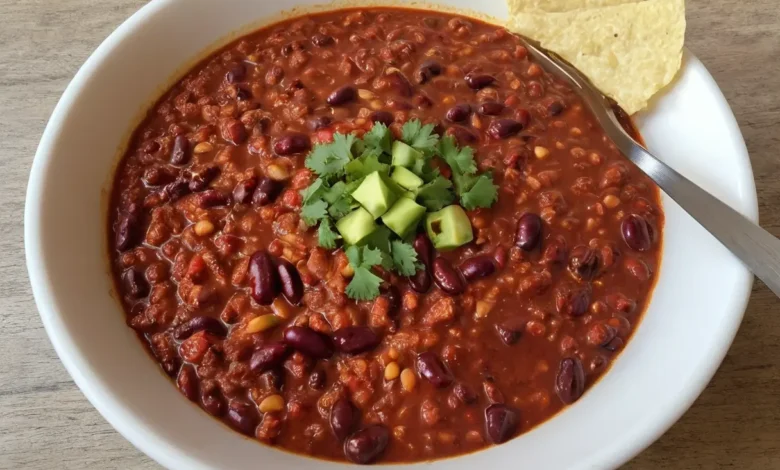How to Make Chili Less Spicy: Simple Tips to Save Your Dish

We’ve all been there—you taste your chili, and suddenly your mouth is on fire! Whether you’ve accidentally added too much chili powder or used extra-spicy peppers, an overly spicy chili can take away the enjoyment of the meal. Fortunately, there are several ways to reduce the heat without losing flavor.
In this guide, we’ll explore some effective and easy techniques to make chili less spicy, so you can save your dish and enjoy it without the burn.
How to Make Chili Less Spicy
1. Add Dairy to Cool the Heat
Dairy products are excellent at neutralizing spiciness. They contain casein, a protein that helps break down the heat-causing compounds (capsaicin) found in peppers.
- Sour Cream or Greek Yogurt: Stir in a dollop of sour cream or Greek yogurt to your chili. This not only cools down the spice but also adds a creamy texture.
- Cheese: Adding cheese, such as cheddar or Monterey Jack, can mellow out the heat and give your chili a rich, savory flavor.
- Milk or Cream: A splash of milk or cream can work wonders in reducing spice levels. Be careful not to add too much as it might thin out the chili.
2. Incorporate Starch to Absorb the Spice
Starchy ingredients can help balance the spice by absorbing some of the heat. Adding more neutral, bland ingredients to your chili can help dilute the spice.
- Potatoes: Adding a few peeled, diced potatoes to your chili will absorb some of the spiciness. Once they are cooked, you can either remove them or leave them in for added texture.
- Rice or Pasta: Serving chili over rice or adding pasta directly into the dish can tone down the spiciness while making it more filling.
- Beans: If your chili recipe already includes beans, adding more can help dilute the heat without changing the overall taste.
3. Increase the Amount of Liquid
Diluting your chili with more liquid is a simple way to spread out the heat, making it less concentrated.
- Broth or Stock: Add more vegetable, beef, or chicken broth to your chili. This will thin out the chili but reduce the intensity of the spice.
- Tomato Sauce or Puree: Adding more tomato sauce or crushed tomatoes can help reduce the spice and enhance the flavor. Tomatoes are naturally acidic, which helps balance the heat as well.
- Water: If you’re looking for a quick fix, simply adding water will dilute the spice. However, you may need to adjust the seasonings afterward to maintain flavor.
4. Sweeten the Pot
Adding a bit of sweetness to your chili can counteract the heat. Sweet ingredients help balance the spice without drastically altering the flavor.
- Sugar or Honey: Start by adding a teaspoon of sugar or honey to your chili. Taste and add more as needed until the spice level is to your liking.
- Maple Syrup or Agave: If you prefer more natural sweeteners, a small drizzle of maple syrup or agave can do the trick. These will add a hint of sweetness while cooling down the spice.
- Carrots: Adding finely grated carrots or diced sweet bell peppers can bring in some natural sweetness and cut down on the spice.
5. Add Acidity to Balance the Heat
Acidic ingredients can help neutralize spiciness and bring a bright, fresh flavor to your chili.
- Lemon or Lime Juice: Squeeze some fresh lemon or lime juice into the chili. The acidity will help cut through the heat and balance the flavors.
- Vinegar: A splash of apple cider vinegar or white vinegar can also help tone down the spiciness. Be sure to add it gradually and taste as you go.
- Tomatoes: Adding more tomatoes, whether fresh, canned, or as a sauce, can provide a natural acidity that will tame the heat.
6. Increase the Volume with Non-Spicy Ingredients
One of the simplest ways to make your chili less spicy is to add more of the non-spicy ingredients already in the recipe. This will help dilute the heat while maintaining the flavor balance.
- Ground Meat: If your chili includes ground beef, chicken, or turkey, you can add more to tone down the spice. Just make sure to adjust the seasoning to taste after adding more meat.
- Vegetables: Adding more vegetables, such as bell peppers, onions, or corn, will dilute the spice and add more volume to your chili.
- Beans: As mentioned earlier, beans are a great way to increase the volume of your chili while neutralizing the heat. Black beans, kidney beans, or pinto beans all work well.
7. Serve with Cooling Sides
If the chili is still too spicy even after making adjustments, you can serve it with cooling side dishes that will help balance out the heat.
- Bread or Tortillas: A slice of bread or a tortilla can help absorb the spiciness and give you something mild to eat along with the chili.
- Rice or Quinoa: Serving chili over a bed of rice or quinoa will not only absorb some of the spice but also make the meal more substantial.
- Avocado or Guacamole: Avocado has a creamy texture that cools down spiciness. Adding slices of avocado or a dollop of guacamole on top of the chili can help reduce the heat.
Frequently Asked Questions (FAQs)
1. Can I fix chili that’s too spicy after it’s cooked?
Yes, you can fix overly spicy chili even after it’s cooked. By adding ingredients like dairy, starch, sweetness, or acidity, you can effectively reduce the heat and save your dish.
2. Will adding more tomatoes reduce the spiciness of chili?
Yes, adding more tomatoes (either fresh, canned, or as a sauce) can help reduce the spiciness of chili. Tomatoes add acidity, which balances out the heat, and they also increase the volume of the dish, diluting the spice.
3. What can I do if I don’t have dairy to cool down the spice?
If you don’t have dairy, you can use starchy ingredients like potatoes or rice, or add sweetness with sugar, honey, or carrots to reduce the spiciness. You can also add acidic elements like lime juice or vinegar to balance the heat.
4. How much sugar should I add to make chili less spicy?
Start with 1 teaspoon of sugar or honey and taste before adding more. You don’t want to make your chili overly sweet, so add it gradually until you reach the desired level of spiciness.
5. Does cooking chili longer make it less spicy?
Cooking chili for a longer period may slightly reduce the intensity of the heat as the flavors meld together. However, the best way to reduce spice is to add neutralizing ingredients like dairy, starch, or sweetness.
Conclusion
Making chili less spicy is easier than you might think. Whether you need to tone down the heat after cooking or you want to prevent your next batch from being too fiery, the techniques we’ve covered will help save your dish. From adding dairy to increasing the volume with non-spicy ingredients, these tips ensure that your chili remains delicious and enjoyable for everyone. With these strategies in your back pocket, you’ll never have to worry about overly spicy chili again!





